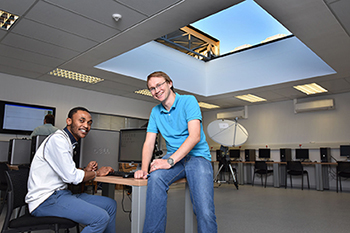UFS Department of Physics offers unique learning experience with on-campus radio telescope

Athanasius Ramaila, an Honours student in the Department of Physics, and Dr Brian van Soelen, a lecturer from the same department, in the laboratory where the radio telescope is housed in the new wing of the Physics Building on the Bloemfontein Campus of the UFS. The telescope will be used to expose graduate students to the basic techniques of radio astronomy.
Photo: Charl Devenish
|
The university this year added a four-storey wing to the existing Physics Building on the Bloemfontein Campus. The new development, which includes four lecture halls and four laboratories, complements other world-class facilities such as the X-ray photoelectron spectroscope and the scanning electron microscope.
A unique asset that distinguishes the UFS Department of Physics from other similar institutions, is the Boyden Observatory situated approximately 27 km northeast of Bloemfontein. The observatory houses a powerful 1.5 m optical telescope, and several smaller, but well equipped telescopes.
According to Pieter Meintjes, Professor in the Department of Physics, the observatory has acquired a new addition - a 0.5 m optical telescope donated by the South African Astronomical Observatory (SAAO) and the National Research Foundation (NRF) to the UFS Astrophysics Group. This optical telescope is one of two powerful optical telescopes used to introduce students to techniques such as photometry and spectroscopy.
“The telescope at Boyden forms an integral part of the Department of Physic’s student training and research programme. Because the UFS is the only university in South Africa operating such a facility, and one of only a few globally, Astrophysics students at the UFS have the unique privilege of having unrestricted access to these telescopes for their MSc and PhD studies,” says Prof Meintjes. In addition, the department has also built a radio telescope as part of a post-graduate student project. The telescope, housed in the new wing of the Physics Building at the Bloemfontein Campus of the UFS, will be used to expose graduate students to the basic techniques of radio astronomy, especially in light of the fact that the SKA is nascent. Prof Meintjes would like to act proactively by grounding his students in the relevant techniques of radio astronomy. The telescope will be used to introduce students to the manner in which radio flux calibrations are performed in order to determine the energy output of an emitting source.
At undergraduate level, the radio telescope will be used, together with optical telescopes in the Astrophysics laboratory, to place students at a high baseline regarding the level of multi-wavelength astrophysics training received at the UFS.
Third-year and Honours students will also have the opportunity of practical training in a research laboratory with 15 computers. The laboratory is equipped with software used to reduce and analyse multi-wavelength data.
“My goal is for the UFS to become the major centre of multi-wavelength astrophysics in South Africa and a key role player in the international arena. To be able to do this, our training should be world class,” Prof Meintjes said.
Aided by its world-class facilities and research, the Department of Physics is competing with the best in the world. Research-wise, a group from the Department of Physics is intensively involved with the SKA Project (Square Kilometre Array), with 3 000 dishes reaching from Carnavon in the Karoo to Mauritius in the Indian Ocean. According to Prof Meintjes, many detailed studies can be conducted with the SKA system of sources, showing major eruptions and mass effluent from the systems. Athanasius Ramaila, a BSc Honours student in Astrophysics at the UFS, has also received a two-year SKA internship, where he will be engaged in the SKA software engineering programme to help with developing software for the telescope.
The UFS Astrophysics Group is focusing on the multi-wavelength study of high-energy astrophysics sources. “This multi-wavelength approach to astrophysics is in line with the recent announcement by government that multi wavelength astrophysics will be the main focus for astrophysics research in South Africa. It is also a very important focus for research in the international arena, as can be seen from the large number of international conferences having a multi-wavelength character,” Prof Meintjes said.